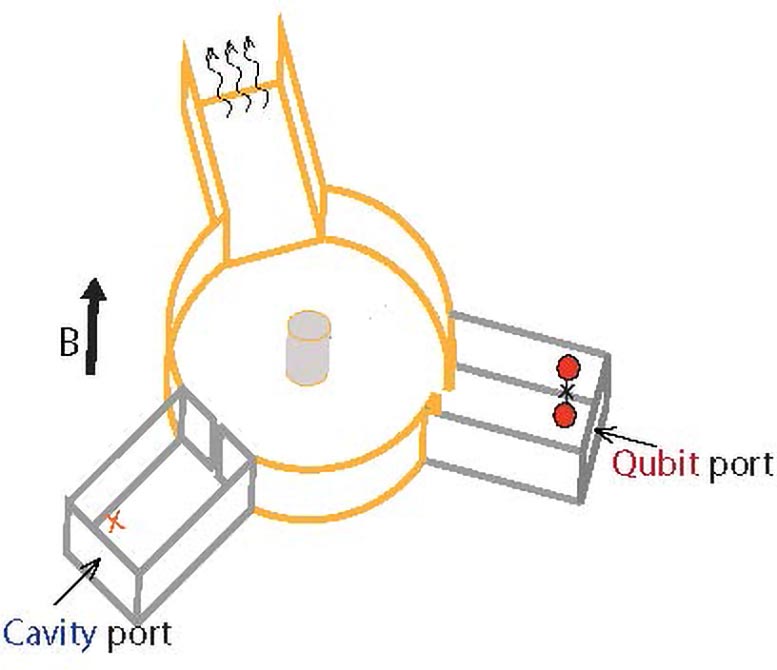
Researchers have made a significant advancement in quantum computing by adapting a microwave circulator to precisely control the nonreciprocity between a qubit and a resonant cavity. This innovation not only enhances the control within quantum computers but also simplifies the theoretical models for future research.
Scientists led by the University of Massachusetts Amherst have adapted a device called a microwave circulator for use in quantum computers, allowing them for the first time to precisely tune the exact degree of nonreciprocity between a qubit, the fundamental unit of quantum computing, and a microwave-resonant cavity. The ability to precisely tune the degree of nonreciprocity is an important tool to have in quantum information processing.
In doing so, the team, including collaborators from the University of Chicago, derived a general and widely applicable theory that simplifies and expands upon older understandings of nonreciprocity so that future work on similar topics can take advantage of the team’s model, even when using different components and platforms. The research was published recently in Science Advances.

Quantum computing differs fundamentally from the bit-based computing we all do every day. A bit is a piece of information typically expressed as a 0 or a 1. Bits are the basis for all the software, websites and emails that make up our electronic world.
By contrast, quantum computing relies on “quantum bits,” or “qubits,” which are like regular bits except that they are represented by the “quantum superposition” of two states of a quantum object. Matter in a quantum state behaves very differently, which means that qubits aren’t relegated to being only 0s or 1s—they can be both at the same time in a way that sounds like magic, but which is well defined by the laws of quantum mechanics. This property of quantum superposition leads to the increased power capabilities of quantum computers.
Furthermore, a property called “nonreciprocity” can create additional avenues for quantum computing to leverage the potential of the quantum world.
“Imagine a conversation between two people,” says Sean van Geldern, graduate student in physics at UMass Amherst and one of the paper’s authors. “Total reciprocity is when each of the people in that conversation is sharing an equal amount of information. Nonreciprocity is when one person is sharing a little bit less than the other.”
“This is desirable in quantum computing,” says senior author Chen Wang, assistant professor of physics at UMass Amherst, “because there are many computing scenarios where you want to give plenty of access to data without giving anyone the power to alter or degrade that data.”
To control nonreciprocity, lead author Ying-Ying Wang, graduate student in physics at UMass Amherst, and her co-authors ran a series of simulations to determine the design and properties their circulator would need to have in order for them to vary its nonreciprocity. They then built their circulator and ran a host of experiments not just to prove their concept, but to understand exactly how their device enabled nonreciprocity. In the course of doing so, they were able to revise their model, which contained 16 parameters detailing how to build their specific device, to a simpler and more general model of only six parameters. This revised, more general model is much more useful than the initial, more specific one, because it is widely applicable to a range of future research efforts.
The “integrated nonreciprocal device” that the team built looks like a “Y”. At the center of the “Y” is the circulator, which is like a traffic roundabout for the microwave signals mediating the quantum interactions. One of the legs is the cavity port, a resonant superconducting cavity hosting an electromagnetic field. Another leg of the “Y” holds the qubit, printed on a sapphire chip. The final leg is the output port.
“If we vary the superconducting electromagnetic field by bombarding it with photons,” says Ying-Ying Wang, “we see that that qubit reacts in a predictable and controllable way, which means that we can adjust exactly how much reciprocity we want. And the simplified model that we produced describes our system in such a way that the external parameters can be calculated to tune an exact degree of nonreciprocity.”
“This is the first demonstration of embedding nonreceptivity into a quantum computing device,” says Chen Wang, “and it opens the door to engineering more sophisticated quantum computing hardware.”
Reference: “Dispersive nonreciprocity between a qubit and a cavity” by Ying-Ying Wang, Yu-Xin Wang, Sean van Geldern, Thomas Connolly, Aashish A. Clerk and Chen Wang, 17 April 2024, Science Advances.
DOI: 10.1126/sciadv.adj8796
Funding for this research was provided by the U.S. Department of Energy, the Army Research Office, Simons Foundation, Air Force Office of Scientific Research, the U.S. National Science Foundation, and the Laboratory for Physical Sciences Qubit Collaboratory.
4 Comments
Is it just me, or is that a flux capacitor?
exactly!
I am glad to know I am not the only one to see the similarity of the two objects. Another check mark in the column of reality being prophesized by make-believe.
Imagination is what propels and is the creation of the sciences, we yearn for how the world works, but at the same time look for solid fact to work with. I have a thought to add the speed of light can be overcome by imagination. I’m here now but at the same time my imagination can be on a world thousands of light years away.